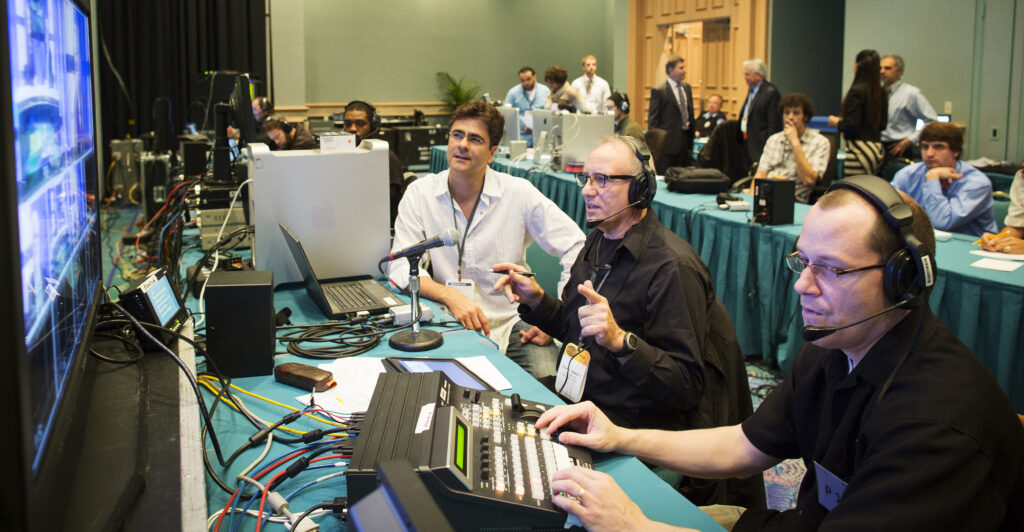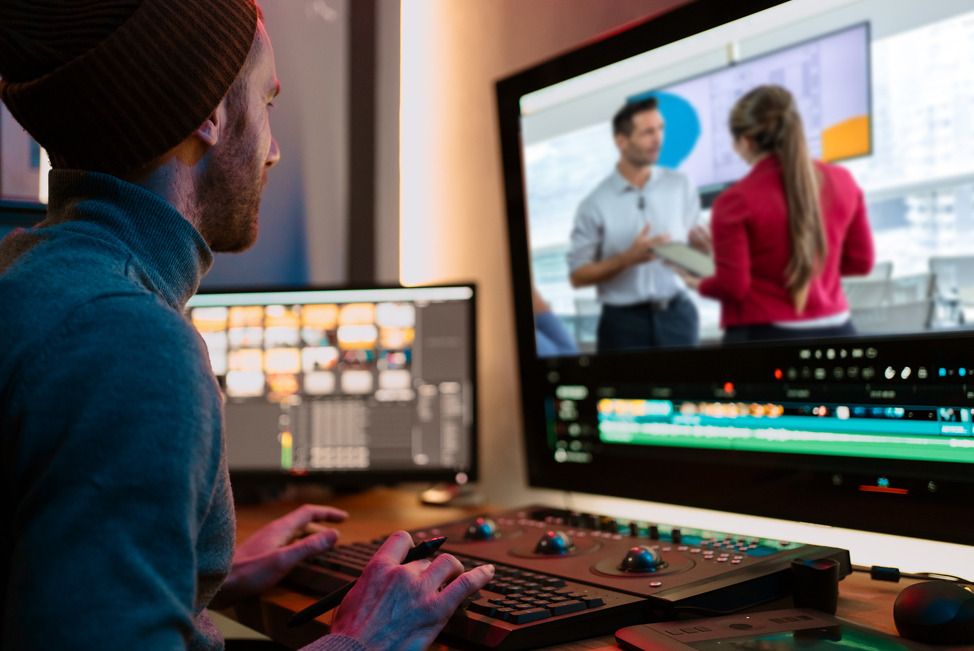At least 10 times a week someone calls my office and asks “How much does it cost to make a video?” or some variation on that.
This is a difficult question to answer because there are so many factors involved – but I’ve given it my best shot. I also included lots of tips on how to save money on video production. And if you scroll down to the end of this blog you’ll see several examples of videos with price ranges listed.
So – how much does it cost to produce a great video? And where does the money go?
Budget Ranges

Just to be clear – if you want a FREE video, grab an iPhone, watch some tutorials on YouTube, have an AI write your script and… good luck! You’ll probably waste a month and end up with results that are just embarrassing. But we’re not talking about that kind of video.
The budget for a PROFESSIONAL video can range from $3,000 for the simplest possible project, up to $50,000 or $200,000 or beyond – depending on the complexity of the concept and the overall quality you’re going for.
Why the huge range?
Because creating a video is a lot like building a house. Do you want a shack, or do you want a mansion? Do you want the cheapest possible video you can get, or do you want a Super Bowl-caliber production? The budgets are going to be completely different – and so will the impact on your audience and the return on your investment.
What Goes Into a Video Budget?

A very simple professional video – a corporate talking head, for example – can be filmed and edited in a day or two. You need a director, a crew member or two, a professional camera, good lighting, a good microphone, and good editing. The budget should be reasonable – perhaps a few thousand dollars at most.
If you add extra elements – a second camera, better lenses, a teleprompter, nicer lighting, and nicer graphics, it will add a few thousand dollars to your total, but it will yield a much better (and more impactful) video. Moving up the scale, a complex video with an ambitious concept will require a team of professionals working for many days or weeks – so of course, the budget will be much higher. But you’ll be able to create a standout video that really gets people’s attention, so if you have the budget it’s worth the expenditure.
A high-end video budget can include concept development, scripting, storyboards, pre-production, casting, a highly-skilled director and crew, on-camera talent, travel, location fees, rehearsals, props, multiple cameras, a large lighting package, audio, specialized gear, sophisticated editing, motion graphics, visual effects, color correction, music scoring, sound design, and more.
If your budget is on the low end, you’ll need to keep it very simple. Forget about expensive location filming, fancy visual effects, and other bells and whistles. Stick to stock footage, a little voiceover narration, stock music, and perhaps a simple shoot.
If your budget is on the higher end, then the sky’s the limit in terms of your options: Ambitious creative concepts, celebrity talent, a week of filming in multiple locations around the world, complex visual effects – you name it, you got it.
What Are the Major Factors that Influence Video Production Budgets?

1) The Concept
A great video always starts with a great idea. If you don’t have a dynamite concept, you’d better hire someone who can come up with one.
Some video production companies have their own in-house creative services departments, with writers, directors, and designers who can develop and storyboard several creative options for you to choose from. Creative development costs money, so budget accordingly. If you’re working with a top agency, this process alone will cost tens of thousands of dollars.
You can save time and money in this phase by doing a lot of research yourself. Go online – search around – and identify several videos that you’d like to use as inspiration. If you give the production company a good sense of your taste and your objectives, you can get everyone on the same page quickly and make sure they’re heading in the right direction.
2) The Script
Investing in a first-rate script can make the difference between a video’s failure and success. The writing style for a video script is completely different from that of a web page or a brochure. And the scriptwriting must have visual concepts baked into it.
If you’re clear on your message and have a good writer on staff, it can be very helpful for you to write the first draft. But if you’re not a superb scriptwriter, don’t make the mistake of trying to write the final script yourself. You could seriously undermine the entire creative process and end up with a seriously boring video that feels like a PowerPoint. Expect to spend $1K on the low end, to $10K or more for a great script by a great writer.
3) Pre-Production
Long before the cameras roll, the creative team will typically spend many days on pre-production: Scouting locations, creating shot lists, drawing storyboards, briefing the crew, choosing the right equipment, getting permits and certificates of insurance for each location, and carefully planning the logistics of each shoot day down to the smallest detail.
Obviously, it costs extra to spend days planning. Usually several thousand dollars. More on a big cinematic project. But skimping on pre-production is a false economy.
Planning ahead helps you avoid costly mistakes and delays on set. It also helps ensure that you capture every critical shot needed for the edit.

4) Locations
Choosing where the shoot takes place is essential to determining the look and feel of your video. Do you have a large, beautiful office (or home) that makes a great impression? Awesome. Take advantage of it and any other visually spectacular settings you can think of. But if your own space is small, dark, or noisy, DON’T try to film there.
You’ll give your audience a terrible impression – find an alternative. Good locations cost thousands of dollars per day – but if you’re resourceful you may be able to get one for free. Do you have a client or colleague who will let you film in a beautiful space in return for a favor? Use your connections. Keep in mind that ambitious videos for global companies are often shot in multiple locations around the world. So plan your budget accordingly.
5) Equipment: Cameras, Lighting, Set Design, and Props
There’s world of difference between videos shot on consumer-grade cameras, and videos shot with top-of-the-line professional cameras with great lenses and great lighting.
If you want amazing shots that keep audiences glued to their screens, allow extra budget for other specialized equipment like dollies, jibs, cranes, drones, specialized lenses, and so on. The better the gear, the better the image, and the more impact on your audience. But this stuff costs money to rent, maintain, power, and insure. Allow another $1K to $10K depending on the exact gear needed to capture the shots.
Production budgets can also include wardrobe, props, and set design, all of which contribute to the look (and ultimately the effectiveness) of your video.

6) The Director, the Crew, On-Camera Talent, and Other Personnel
Even if you invest in the best equipment, if you don’t have the right people operating all this stuff, then the tools are useless. A very small, simple shoot can be handled by a single director/camera operator wearing multiple hats, plus a second crew member help carry and set up the equipment. On larger projects, the crew can easily number 10 to 20 or more talented people with highly specialized skills.
The director is in charge of the shoot and is responsible for bringing the video to life. The director typically works hand in hand with a producer – or they may be the same person on smaller productions.
The crew may include a director of photography, multiple camera operators, an audio engineer, gaffers, grips, location managers, prop managers, wardrobe stylists, hair and makeup artists, production assistants, and more.
And of course don’t forget actors and extras, if your concept calls for them. The budget for actors ranges all the way from a few hundred dollars for someone competent but relatively inexperienced, up to $100K or more per day for celebrity talent. (Note: Sometimes yesterday’s celebrities, whose careers are no longer hot, can be hired for a lot less than you’d think.)
Keep in mind that everyone works on day rates. The producer needs to carefully manage the shoot in order to avoid costly overtime fees at the end of the day.
7) The Shoot Schedule
A small-scale video can easily be shot in a day. Larger-scale productions can take a week or more. Factor in the rental rates for equipment and day rates for the crew… you can quickly see how each additional day of shooting adds to the budget.
Here’s an important tip: The more you can shoot in a day, the more bang for the buck you get. Do you need to interview five people for a video? If you schedule them all on the same day, in the same place, you’ll save thousands of dollars compared to interviewing them on different days in different places.
8) Miscellaneous Expenses: Transportation, Food, Hard Drives, Insurance, etc.
Don’t forget to factor in daily parking, meals for the crew, hard drives for the raw footage, and other small out-of-pocket expenses. A professional production company will already have the standard insurance required by most locations. However, if you’re closing down a street, or dealing with an unusual venue, special insurance may be required – which may cost several thousand extra dollars.

9) Post-Production: Editing and Graphics
Editing budgets are determined by the skill level of the editor, the number of days of editing required, the amount of footage shot, the length of the finished video, and many other factors.
Graphics can range from a simple opening title to unbelievably sophisticated design and visual effects. If you want truly inspiring motion graphics, budget anywhere from $5K on the low end to $50K – or more – depending on what’s involved.
10) Music and Sound Design
Music and sound design are vastly more important than most people realize. A great music score can bring a video to life, and bad music will kill it instantly.
Composing an original score can be expensive, but worth every penny in terms of the impact on the audience.
But even if you’re just using stock music, it takes great skill to sift through hundreds – or thousands – of mediocre tracks to find that one musical gem that works perfectly. DON’T settle for bad music.
Sound design refers mainly to sound effects, which can be subtle or dramatic. A Hollywood action movie becomes truly exciting only after the sound department adds all the whooshes, crashes, and explosions that make you jump out of your seat. In the same way, the richness of great sound design will enhance the impact of any video. Expect to spend anywhere from $1K to $3K on sound design for a one or two-minute video, depending on what’s involved.

11) Video Distribution and Video Seeding
There’s no point investing tens of thousands of dollars in creating a brilliant video if nobody sees it.
Hoping it goes viral on YouTube isn’t a plan and won’t work. But there’s good news: If you can accurately describe your audience demographics, and your ideal customer, video SEO, and video distribution will ensure that the right people see your video. Allow $1K to $20K for a significant campaign.
Update (06.06.2023):
Online Video Distribution Companies vs. Traditional Media.
As years pass, online video distribution becomes an even more robust and powerful tool and is constantly transforming the content consumption landscape. In the digital age, reaching audiences through online video distribution offers many benefits over traditional media, including a global reach and targeted marketing options that keep growing and delivering ever more accurate audience selection, as well as analytics and insights. Another feature of online distribution that traditional media lacks is interactive and engaging experiences, such as comments, likes, shares, and subscriptions. Online distribution even offers you monetization options for the content that you create.
Example Videos
Here are some examples of very successful videos, from lower budget to higher budget.
VIDEOS IN THE $15K - $20K RANGE:
McGraw-Hill Education: Studio Space – stock footage combined with lots of graphics to help tell the story
Killi: Your Data Revolution – stock images, with great motion graphics and sound design
VIDEOS IN THE $50K RANGE:
GetYourHealthRecord.com – A one-day shoot with a cast of 10, cool graphics and sound design
Anker Quick Charge – This spot got more than 14 million views on YouTube!
VIDEOS IN THE $60K RANGE:
Formula E Racing: Championship – Original filming, great editing, amazing sound design. This premiered on the Jumbotron at the famed New York Auto show!
Pinkerton: Global Risk Management – We transformed what COULD have been a boring talking head video into a high-end promo with very cool original graphics and rich location footage.
VIDEOS IN THE $100K+ RANGE:
TAG Watches – Connected Man – Killer concept, high-end shooting, insane schedule – filmed in 12 locations! (Awesome work, Michael)
Markit Collaboration Services – Completely original:60 commercial that premiered on Bloomberg TV. We built 8 cities around the world in CG, building by building, in full 4K resolution, for this epic spot.
PetMeds: Fashion Fiasco – National ad for linear and non-linear television. We led this project from creative development through post-production, including script development, location scouting, costume design, human and animal casting, and the high-end shoot.
